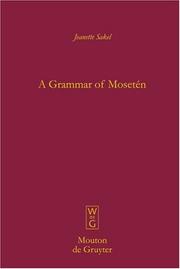| Listing 1 - 10 of 17 | << page >> |
Sort by
|

ISBN: 3110183404 3110915286 Year: 2004 Publisher: Berlin Mouton de Gruyter
Abstract | Keywords | Export | Availability | Bookmark
 Loading...
Loading...Choose an application
- Reference Manager
- EndNote
- RefWorks (Direct export to RefWorks)
Book
ISBN: 9783110915280 Year: 2011 Publisher: Berlin Boston
Abstract | Keywords | Export | Availability | Bookmark
 Loading...
Loading...Choose an application
- Reference Manager
- EndNote
- RefWorks (Direct export to RefWorks)

ISBN: 9783110915280 9783110183405 Year: 2011 Publisher: Berlin ;; Boston De Gruyter Mouton
Abstract | Keywords | Export | Availability | Bookmark
 Loading...
Loading...Choose an application
- Reference Manager
- EndNote
- RefWorks (Direct export to RefWorks)
Book
ISBN: 1282194720 9786612194726 311019919X 9783110199192 311019628X 9783110196283 9783110196283 9781282194724 6612194723 Year: 2007 Publisher: New York : Mouton de Gruyter,
Abstract | Keywords | Export | Availability | Bookmark
 Loading...
Loading...Choose an application
- Reference Manager
- EndNote
- RefWorks (Direct export to RefWorks)
The book contains 30 descriptive chapters dealing with a specific language contact situation. The chapters follow a uniform organisation format, being the narrative version of a standard comprehensive questionnaire previously distributed to all authors. The questionnaire targets systematically the possibility of contact influence / grammatical borrowing in a full range of categories. The uniform structure facilitates a comparison among the chapters and the languages covered. The introduction describes the setup of the questionnaire and the methodology of the approach, along with a survey
Language and languages --- Grammar, Comparative and general. --- Comparative grammar --- Grammar --- Grammar, Philosophical --- Grammar, Universal --- Philosophical grammar --- Linguistics --- Philology --- Foreign elements. --- Grammar, Comparative --- Comparative linguistics --- Language Contact, Language Typology.
Book
ISBN: 3050057688 9783050057682 3050057033 Year: 2012 Publisher: Berlin : Akademie Verlag,
Abstract | Keywords | Export | Availability | Bookmark
 Loading...
Loading...Choose an application
- Reference Manager
- EndNote
- RefWorks (Direct export to RefWorks)
Der vorliegende Band bietet vielfältige Herangehensweisen zu den Sprachen der indigenen Völker Amerikas - zu den großen Sprachen (Guaraní, Zapotekisch, Otomí, klassisches Aztekisch) ebenso wie zu den kleinen (Mosetén, Cabécar). Die Einflüsse der amerindischen Sprachen auf die Ideengeschichte der Sprachwissenschaft werden genauso berücksichtigt wie die vielfältigen Kontaktbeziehungen (vornehmlich zum Spanischen) und Gesichtspunkte der kulturellen Diversität. Sprachen mit relativ langer Schriftlichkeitstradition stehen neben Sprachen, mit deren Verschriftung erst kürzlich begonnen wurde. Das Analysespektrum reicht von der Synopse grammatischer Gesamtsysteme bis zur Untersuchung von Einzelaspekten aus dem Leben der Sprachen. So wird der thematische Reichtum des Forschungsgebietes umfassend abgebildet. Der Band enthält sowohl Beiträge, die sich an ein linguistisch-philologisch vorgebildetes Publikum richten, als auch solche, die interessierte Laien ansprechen. Er versammelt die Vorträge des Gründungskolloquiums Europäisches Netzwerk für Amerindische Linguistik (ENAL), die im Oktober 2009 im Rahmen des Festivals der Sprachen in Bremen gehalten wurden.
Indians of South America --- Indians of North America --- Endangered languages. --- Language and culture. --- Culture and language --- Culture --- At-risk languages --- Disappearing languages --- Dying languages --- Fading languages --- Nearly extinct languages --- Threatened languages --- Vanishing languages --- Language and languages --- Language obsolescence --- Languages. --- America --- Americas --- New World --- Western Hemisphere --- Languages --- History.
Multi
ISBN: 9780521837279 9780521545983 0521545986 9781139016254 0521837278 1139209396 1139222228 9786613571243 1139016253 1139217410 1139214330 1139220500 1139223933 1280393327 Year: 2012 Volume: *87 Publisher: Cambridge New York Melbourne [etc.] : Cambridge University Press,
Abstract | Keywords | Export | Availability | Bookmark
 Loading...
Loading...Choose an application
- Reference Manager
- EndNote
- RefWorks (Direct export to RefWorks)
A handy beginner's guide, this textbook introduces the various stages of linguistic fieldwork, from the preparation of the work to the presentation of the results. Drawing on over forty years of fieldwork experience between them, in over two dozen languages, the authors pack the book with examples and anecdotes from their experiences and include practical exercises for students to test what they have learned. Independent of any particular perspective, the methods can be applied to a wide range of fieldwork settings, for projects with very different theoretical backgrounds and without the need to travel too far. The book covers 'traditional fieldwork' such as language description and documentation, as well as less typical methods, including language contact and quantitative studies with experiments or questionnaires
Linguistics --- Languages, Modern --- Fieldwork --- Study and teaching --- Linguistique --- Méthodologie --- Recherche sur le terrain --- Fieldwork. --- LANGUAGE ARTS & DISCIPLINES --- General. --- Languages, modern --- Language arts & disciplines --- Linguistic science --- Science of language --- Language and languages --- Foreign languages --- Languages, Foreign --- Languages, Living --- Living languages --- Modern languages --- Recherche sur le terrain. --- Linguistics - Fieldwork --- Languages, Modern - Study and teaching - Handbooks, manuals, etc. --- Méthodologie
Dissertation
Abstract | Keywords | Export | Availability | Bookmark
 Loading...
Loading...Choose an application
- Reference Manager
- EndNote
- RefWorks (Direct export to RefWorks)
Dissertation
Abstract | Keywords | Export | Availability | Bookmark
 Loading...
Loading...Choose an application
- Reference Manager
- EndNote
- RefWorks (Direct export to RefWorks)
Dissertation
Year: 2003 Publisher: Nijmegen : s.n.,
Abstract | Keywords | Export | Availability | Bookmark
 Loading...
Loading...Choose an application
- Reference Manager
- EndNote
- RefWorks (Direct export to RefWorks)
Dissertation
Year: 2003 Publisher: Nijmegen : s.n.,
Abstract | Keywords | Export | Availability | Bookmark
 Loading...
Loading...Choose an application
- Reference Manager
- EndNote
- RefWorks (Direct export to RefWorks)
| Listing 1 - 10 of 17 | << page >> |
Sort by
|

 Search
Search Feedback
Feedback About UniCat
About UniCat  Help
Help News
News